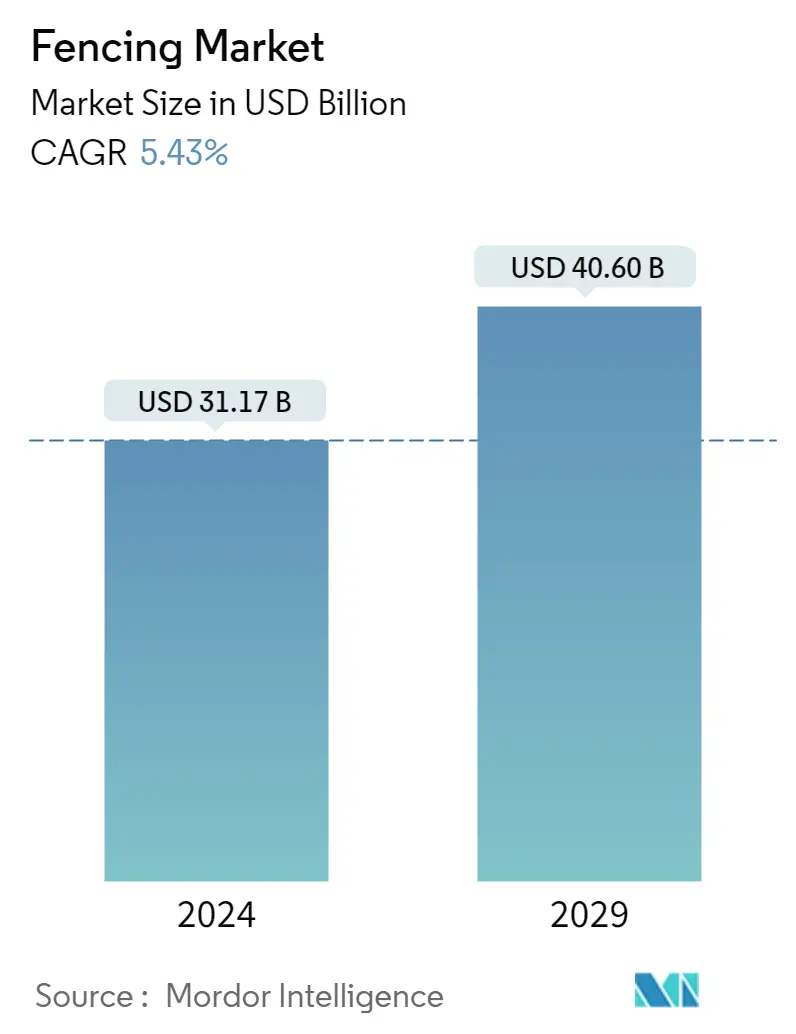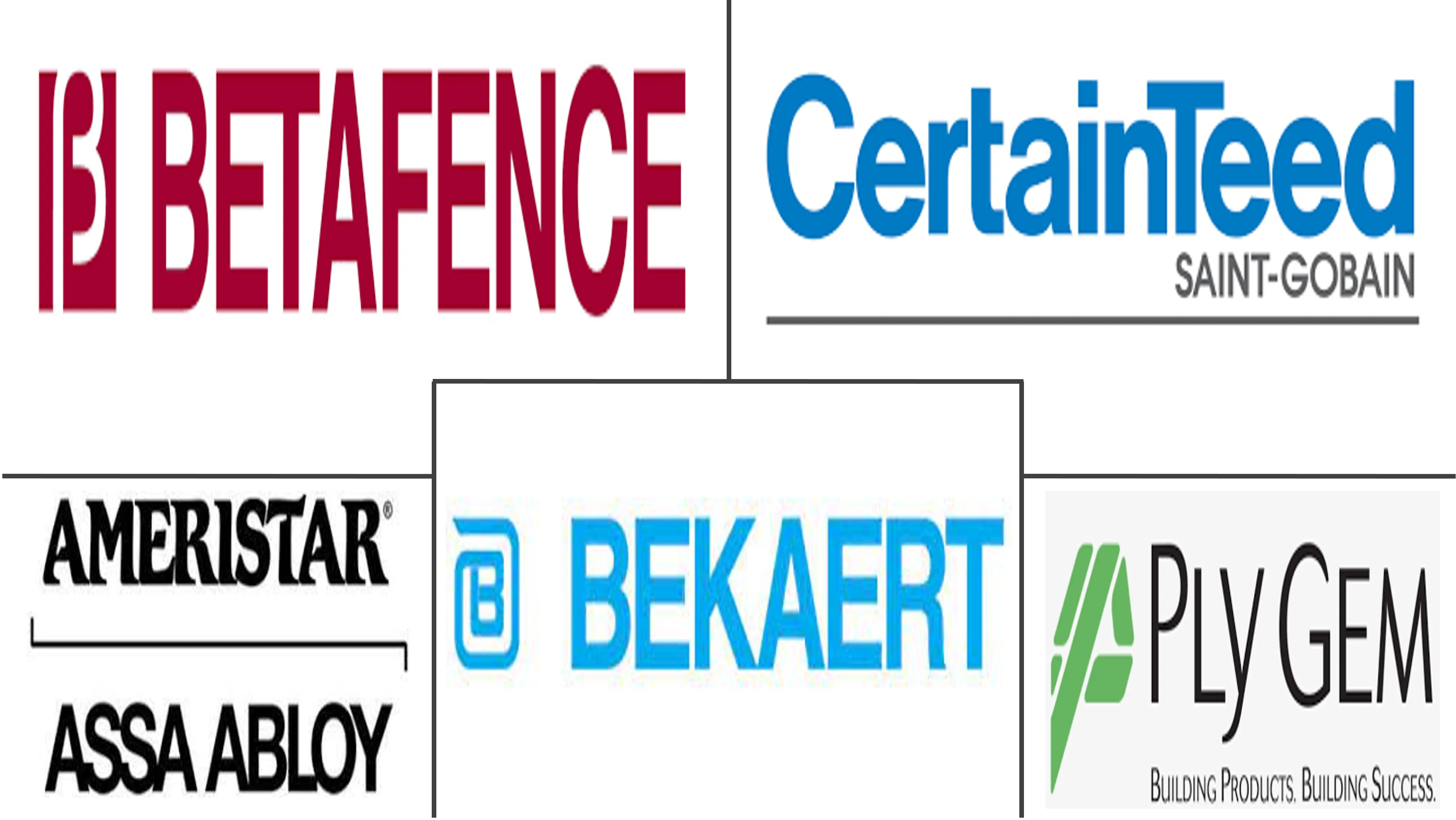Market Size of Fencing Industry

| Study Period | 2020 - 2029 |
| Market Size (2024) | USD 31.17 Billion |
| Market Size (2029) | USD 40.60 Billion |
| CAGR (2024 - 2029) | 5.43 % |
| Fastest Growing Market | North America |
| Largest Market | North America |
| Market Concentration | Low |
Major Players
*Disclaimer: Major Players sorted in no particular order |
Fencing Market Analysis
The Fencing Market size is estimated at USD 31.17 billion in 2024, and is expected to reach USD 40.60 billion by 2029, growing at a CAGR of 5.43% during the forecast period (2024-2029).
- The surge in commercial and residential construction projects is fueling the need for fencing, prompting advancements and innovations in manufacturing to meet the rising demand for dependable and long-lasting fencing systems. Notably, the residential sector is experiencing an uptick in new builds and remodeling activities worldwide, serving as a primary catalyst for the global fencing market.
- Manufacturing firms continually strive to enhance their products to align with customer requirements, contributing to regional market growth. In North America and Europe, there's a notable emphasis on safeguarding pets and assets, bolstering protection against theft and various forms of criminal activity. Moreover, there's a considerable demand for renovation and retrofit projects throughout Europe. Government-backed initiatives prioritize cost-efficient solutions, leading to an increased preference for plastic fences.
- Asia-Pacific presents promising prospects for the fencing market, given its inclusion of rapidly developing nations like China and India, attracting considerable investor interest. However, trade disputes and economic deceleration persist in the region, particularly in China and India, where subdued domestic demand has led to reductions in investments and production across various sectors, including manufacturing.
- Military organizations often employ electric fencing to deter intrusions near international borders. Notably, China's military utilizes spiked electric wires in the Ladakh region along the disputed border with India, while the Russian military has installed electric fencing along the China-Russia border for protection. The growing focus on national security is expected to drive market growth, as electric fencing not only deters unauthorized human entry but also prevents wildlife encroachment, significantly enhancing farm safety. However, the market expansion is hindered by the substantial maintenance costs associated with electric fencing, which require regular inspections for optimal performance. Alternative solutions, such as unmanned crossings, are being explored to address these challenges and mitigate high fixed costs.
- The fencing market is segmented into three categories based on applications: industrial, agricultural, and residential. Residential construction and remodeling activities are driving the expansion of the residential segment, supported by rising disposable incomes and the increasing importance households place on security and privacy. Furthermore, there is a growing demand for distinctive fences to enhance the aesthetic appeal of residential properties. In the agricultural sector, rapid growth is anticipated due to the need to protect farms, crops, and livestock from wildlife and theft. This increased demand for agricultural fencing is driven by rising instances of agricultural intrusions, leading to the customization of fences according to customer specifications and the use of high-quality raw materials.
Fencing Industry Segmentation
A fence is an artificially constructed barrier of any material or combination of materials erected to enclose or screen areas of land. A complete background analysis of the fencing market, including the assessment of the economy and contribution of sectors in the economy, a market overview, market size estimation for key segments, emerging trends in the market segments, market dynamics and geographical trends, and COVID-19 impact, is covered in the report.
The fencing market is segmented by type (wood fencing, metal fencing, and other types), end user (residential, agricultural, military and defense, government, petroleum and chemicals, mining, energy and power, warehouse, and other end users), and geography (North America, Latin America, Europe, Asia-Pacific, and Middle East and Africa).
The report offers global fencing market size and forecasts in value (USD) for all the above segments.
| By Type | |
| Wood Fencing | |
| Metal Fencing | |
| Other Types |
| By End User | |
| Residential | |
| Agricultural | |
| Military and Defense | |
| Government | |
| Petroleum and Chemicals | |
| Mining | |
| Energy and Power | |
| Warehouse | |
| Other End Users |
| By Geography | |||||||
| |||||||
| |||||||
| |||||||
| |||||||
|
Fencing Market Size Summary
The fencing market is poised for significant growth, driven by the increasing demand in both commercial and residential construction sectors. This demand is prompting innovations in manufacturing to create reliable and durable fencing solutions. The residential sector, in particular, is witnessing a surge in new builds and remodeling activities, which is a key factor propelling the market forward. In regions like North America and Europe, there is a strong focus on enhancing security for pets and assets, as well as protecting against theft and criminal activities. The agricultural sector is also contributing to market expansion, with a rising need to safeguard farms, crops, and livestock from wildlife and theft. This has led to a customization of fencing solutions, utilizing high-quality materials to meet specific customer needs.
The Asia-Pacific region presents promising opportunities for market growth, despite challenges such as trade disputes and economic slowdowns in countries like China and India. The fencing market is segmented into industrial, agricultural, and residential categories, with each segment experiencing unique growth drivers. In North America, the demand for wood fencing is on the rise, driven by consumer preferences for privacy and security, as well as aesthetic enhancements. The market is characterized by a fragmented landscape with numerous players, including major companies like CertainTeed, PLY Gem, and Bekaert. Strategic partnerships, mergers, and acquisitions are common as companies seek to expand their market presence. The focus on sustainability is also influencing consumer choices, with eco-friendly materials gaining traction. Overall, the fencing market is expected to continue its upward trajectory, supported by urbanization, rising disposable incomes, and the expansion of the middle class.
Fencing Market Size - Table of Contents
-
1. MARKET INSIGHTS
-
1.1 Current Market Scenario
-
1.2 Technological Trends
-
1.3 Insights on Supply Chain/Value Chain Analysis
-
1.4 Government Regulations
-
1.5 Insights on Materials Used for Fencing
-
1.6 Impact of COVID-19 on the Market
-
-
2. MARKET SEGMENTATION
-
2.1 By Type
-
2.1.1 Wood Fencing
-
2.1.2 Metal Fencing
-
2.1.3 Other Types
-
-
2.2 By End User
-
2.2.1 Residential
-
2.2.2 Agricultural
-
2.2.3 Military and Defense
-
2.2.4 Government
-
2.2.5 Petroleum and Chemicals
-
2.2.6 Mining
-
2.2.7 Energy and Power
-
2.2.8 Warehouse
-
2.2.9 Other End Users
-
-
2.3 By Geography
-
2.3.1 North America
-
2.3.1.1 United States
-
2.3.1.2 Canada
-
2.3.1.3 Mexico
-
-
2.3.2 Latin America
-
2.3.2.1 Brazil
-
2.3.2.2 Colombia
-
2.3.2.3 Argentina
-
2.3.2.4 Rest of Latin America
-
-
2.3.3 Europe
-
2.3.3.1 Germany
-
2.3.3.2 United Kingdom
-
2.3.3.3 France
-
2.3.3.4 Russia
-
2.3.3.5 Rest of Europe
-
-
2.3.4 Asia-Pacific
-
2.3.4.1 China
-
2.3.4.2 Japan
-
2.3.4.3 India
-
2.3.4.4 South Korea
-
2.3.4.5 Rest of Asia-Pacific
-
-
2.3.5 Middle East and Africa
-
2.3.5.1 Saudi Arabia
-
2.3.5.2 Egypt
-
2.3.5.3 South Africa
-
2.3.5.4 United Arab Emirates
-
2.3.5.5 Rest of Middle East and Africa
-
-
-
Fencing Market Size FAQs
How big is the Fencing Market?
The Fencing Market size is expected to reach USD 31.17 billion in 2024 and grow at a CAGR of 5.43% to reach USD 40.60 billion by 2029.
What is the current Fencing Market size?
In 2024, the Fencing Market size is expected to reach USD 31.17 billion.

